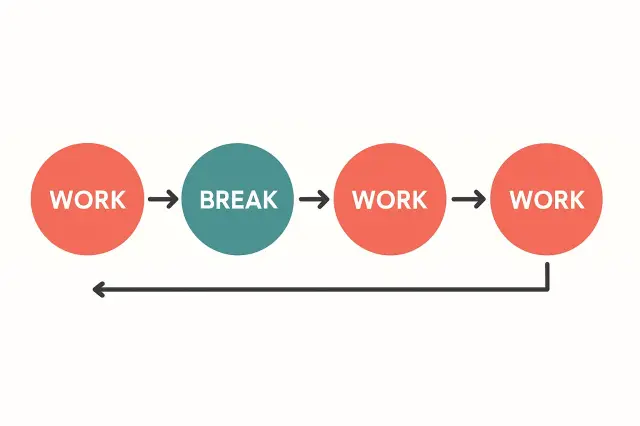Time blocking has evolved into a productivity phenomenon used by CEOs, entrepreneurs, athletes, creators, and students around the world. Instead of letting tasks fill the day randomly, users divide their time into structured, intentional blocks. The technique appeals to high performers because it simplifies decision-making, reduces stress, and increases efficiency.
Today, both corporate leaders and students rely on digital tools such as the Time Blocking Planner from Calculatorr.com (https://calculatorr.com/productivity-calculators) to organize their priorities with accuracy. The combination of planning, focus, and structure explains why this technique keeps trending on social media, in business circles, and among productivity experts.
Insert Image 1 here
Suggested image description
"A person organizing their day using a digital time blocking planner. Alt text: Daily schedule organized with color-coded time blocks for focus and productivity."
How CEOs Use Time Blocking to Maximize Impact
CEOs operate with extremely limited time. Every minute must count. Time blocking allows them to:
-
Reduce decision fatigue
-
Prioritize high-impact tasks
-
Protect time for deep work
-
Create predictable routines
-
Balance communication, meetings, and strategic thinking
H3 Deep Work Sessions for Strategic Thinking
Most executives schedule 2–3 blocks per week dedicated exclusively to strategy. During these hours they eliminate interruptions, close email, and disable notifications. The Time Blocking Planner helps them allocate these sessions in advance with clear boundaries and durations.
H3 Meeting Consolidation and Control
Meetings easily take over a CEO's schedule. By using time blocks, they can group similar meetings together, limit duration, and avoid unnecessary context switching. This practice increases efficiency and frees up time for leadership tasks.
H3 Personal Energy Optimization
High performers know that not all hours feel equal. They use time blocking to assign demanding tasks during peak energy hours and reserve lighter tasks for afternoons. The Time Blocking Planner makes it simple to visualize these patterns and adjust the schedule accordingly.
Why Students Are Also Embracing Time Blocking
Students face challenges similar to CEOs: many tasks, tight schedules, and distractions everywhere. Time blocking helps them bring clarity to their academic life and create structure.
-
Improves study habits
-
Encourages consistency
-
Reduces procrastination
-
Helps balance school, part-time work, and personal time
-
Creates a realistic routine for exams and projects
H3 Time Blocking for Study Sessions
With short, focused blocks, students divide their subjects into manageable units. This technique avoids overwhelm and increases retention. Pairing time blocking with the Pomodoro Timer (https://calculatorr.com/productivity-calculators) amplifies results, especially during long study days.
H3 Managing Homework, Classes, and Free Time
Students use time blocks to map every part of the day:
-
classes
-
homework
-
study sessions
-
rest
-
meals
-
extracurricular activities
-
personal routines
A complete visual schedule makes responsibilities clear and prevents double-booking.
H3 Reducing Procrastination
Procrastination often comes from uncertainty. Time blocking removes ambiguity by stating exactly what to do and when to do it. Students who combine the technique with the Procrastination Calculator (https://calculatorr.com/productivity-calculators) gain awareness of time lost and stay more consistent.
Insert Image 2 here
Suggested image description
"Student using a laptop with a color-coded time blocking schedule. Alt text: Student time blocking planner for organizing study sessions and assignments."
How to Use the Time Blocking Planner from Calculatorr.com
The Time Blocking Planner is designed to be simple, intuitive, and flexible. It works for both beginners and experienced planners.
Step-by-Step Guide
H3 1. Define Your Priorities
Before creating blocks, choose the top tasks of the day:
-
academic tasks
-
work tasks
-
personal responsibilities
-
health routines
-
creative time
-
rest and recovery
The planner helps you place these tasks into precise time slots.
H3 2. Assign Time Blocks
Use the digital interface to schedule the tasks:
-
Morning: deep work or study
-
Midday: meetings or classes
-
Afternoon: lighter tasks
-
Evening: personal time
Each block has a clear start and end time, which improves focus and accountability.
H3 3. Add Color Codes
Colors create visual clarity. People typically use:
-
Blue for deep work
-
Yellow for meetings or classes
-
Green for personal time
-
Red for urgent tasks
-
Purple for creative projects
Color coding is one of the most effective ways to stay organized.
H3 4. Review and Adjust Your Day
Time blocking is flexible. If tasks take longer or new priorities arise, simply adjust the blocks in the planner.
H3 5. Track Your Results Over Time
Use the Time Blocking Planner consistently and evaluate:
-
productivity peaks
-
energy levels
-
completed tasks
-
time lost to distractions
-
routines that work
-
routines that need improvement
This level of self-awareness leads to constant optimization.
Real-Life Use Cases for CEOs
H3 Weekly Strategic Planning
A CEO uses the planner to reserve 3 deep work blocks on Monday, Wednesday, and Friday. These become non-negotiable times for strategy, analysis, or reviewing key business metrics.
H3 Meeting Reduction
By grouping all meetings into two afternoon blocks, the CEO frees up mornings for concentrated thinking rather than interruptions.
H3 Work-Life Balance
Time blocking helps executives prioritize personal activities such as exercise, family time, and reading—activities often neglected under busy schedules.
Real-Life Use Cases for Students
H3 Final Exam Preparation
A university student divides subjects into 45-minute blocks using the planner. Each block is dedicated to a specific topic, reducing overwhelm and maximizing retention.
H3 Balancing Work and Study
Part-time students use time blocks to schedule classes, shifts, assignments, and rest time, creating a sustainable weekly routine.
H3 Breaking Down Projects
Large assignments become manageable when split into research, planning, writing, editing, and review blocks.
Why Time Blocking Works Better Than Traditional To-Do Lists
Traditional to-do lists tell you what to do. Time blocking tells you when to do it. This key difference is why CEOs and students prefer this technique.
Benefits Compared to To-Do Lists
-
Prevents tasks from expanding indefinitely
-
Forces realistic planning
-
Eliminates multitasking
-
Protects focus
-
Enhances discipline
-
Provides a visual structure
-
Reduces stress and decision fatigue




